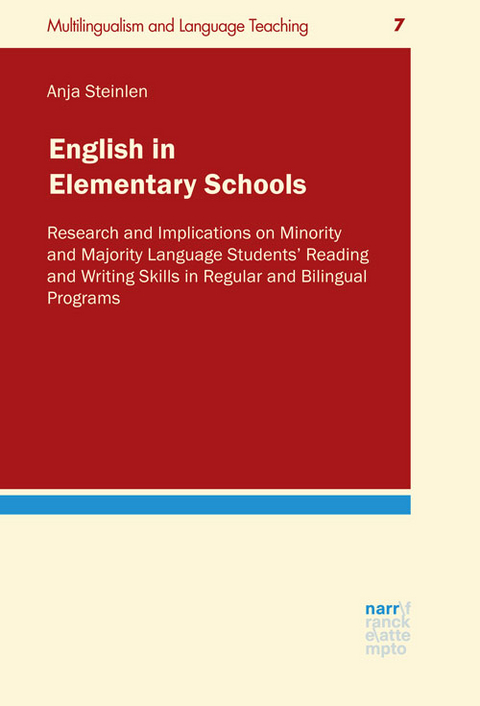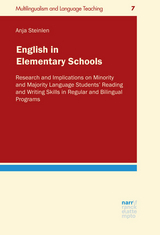English in Elementary Schools
Narr Francke Attempto (Verlag)
978-3-8233-8451-9 (ISBN)
An increasing number of multilingual students, often with a migration background, are attending elementary schools in Germany these days. Also on the rise is the number of schools offering a bilingual program, where content subjects such as science and mathematics are taught in a foreign language. This book explores minority and majority language students' German and English reading and writing skills in elementary schools which offer either regular English-as-subject lessons or bilingual programs with varying degrees of English intensity. The focus is on effects of foreign language input intensity with respect to students' language background, gender, cognitive abilities, and socio-economic background. This book also provides recommendations for English reading and writing activities in the elementary school classroom.
Dr. habil. Anja K. Steinlen ist wissenschaftliche Mitarbeiterin am Lehrstuhl für Fremdsprachendidaktik an der Friedrich-Alexander-Universität Erlangen-Nürnberg
Acknowledgements
Contents
1. Introduction
1.1 Factors affecting (foreign) language learning
2. Literature review
2.1 Definitions
2.1.1 Literacy
2.1.2 L1 reading
2.1.3 L2 reading
2.1.4 L1 writing
2.1.5 L2 writing
2.1.6 Some problems relating to phoneme-grapheme correspondences in German and English
2.2 English programs in elementary schools in Germany
2.2.1 Regular early foreign language programs in Germany
2.2.1.1 Controversial views on EFL reading and writing in elementary school
2.2.1.2 Curricula for English as a subject relating to reading and writing
2.2.1.3 English textbooks
2.2.1.4 Studies on regular EFL English programs in Germany
2.2.2 Bilingual programs
2.2.2.1 Characteristics of bilingual programs
2.2.2.2.1 Differences between bilingual programs and EFL programs
2.2.2.1.2 Different bilingual programs: CLIL vs. IM
2.2.2.1.3 Intensity of different bilingual programs
2.2.2.1.4 Bilingual programs as "elitist" programs
2.2.2.2 Curricula for bilingual teaching in Germany
2.2.2.3 Teacher supply for bilingual programs in Germany
2.2.2.4 Supply of materials for bilingual programs
2.2.2.5 Assessment in bilingual programs
2.2.2.6 Studies on L1 and L2 reading and writing in bilingual programs
2.2.2.6.1 L1 reading and writing
2.2.2.6.2 FL skills in regular vs. bilingual programs
2.2.2.6.3 FL skills in bilingual programs with differing FL intensity
2.3 Multilingual background
2.3.1 Facts and figures
2.3.2 School language literacy by language background
2.3.2.1 Minority language children's German literacy skills in regular programs
2.3.2.2 Minority language children's German literacy skills in bilingual programs
2.3.3 FL literacy by language background (L3 acquisition)
2.3.3.1 General models of L3 acquisition
2.3.3.2 FL skills of minority language children in regular FL programs
2.3.3.2.1 L3 Reading in regular programs
2.3.3.2.2 L3 Writing in regular programs
2.3.3.3 Foreign language skills of minority language children in bilingual programs
2.3.3.3.1 L3 reading in bilingual programs
2.3.3.3.2 L3 writing in bilingual programs
2.4 Gender
2.4.1. L1 literacy skills by gender
2.4.1.1 L1 literacy skills in mainstream programs by gender
2.4.1.2 L1 literacy skills in bilingual programs by gender
2.4.2 FL literacy skills by gender
2.4.2.1 FL literacy skills in mainstream programs by gender
2.4.2.2 FL literacy skills in bilingual programs by gender
2.4.2.3 Model of gender differences in FL learning
2.4.3 The interaction of gender and minority language background in language learning
2.5 Cognitive variables (focusing on nonverbal intelligence)
2.5.1 Nonverbal intelligence and bilingual children
2.5.2 Literacy skills by nonverbal intelligence
2.6 Social background
2.6.1 L1 literacy skills by SES
2.6.2 FL literacy skills by SES
2.6.3 The interaction of SES and language background on literacy skills
3. Research questions
4. Method
4.1 The schools and their programs
4.1.1 The Bili-50 program
4.1.2 The EFL program
4.1.3 The Bili-20 program
4.1.4 The Bili-70 program
4.2 Test material
4.2.1 Control measures: Family background and cognitive background
4.2.2 English tests
4.2.3 German tests
4.3 Subjects
5. Results
5.1 Within-group comparisons
5.2 Between-group comparisons
6. Discussion
6.1 Effectivity
6.1.1 German
6.1.2 English
6.1.2.1 Partial IM programs
6.1.2.2 Less intensive FL programs
EFL group
6.2 Language background
6.2.1 German
6.2.2 English
6.3 Gender
6.3.1 German
6.3.2 English
6.3.3 Interaction between gender and language background
6.4 Control variables
6.4.1 Cognitive background
6.4.2 Social background
6.5 Summary, limitations and future studies
6.5.1
| Erscheinungsdatum | 15.12.2020 |
|---|---|
| Reihe/Serie | Multilingualism and Language Teaching ; 7 |
| Sprache | englisch |
| Maße | 150 x 220 mm |
| Gewicht | 324 g |
| Themenwelt | Schulbuch / Wörterbuch ► Wörterbuch / Fremdsprachen |
| Geisteswissenschaften ► Sprach- / Literaturwissenschaft ► Sprachwissenschaft | |
| Schlagworte | Foreign Language Teaching • Fremdsprachenunterricht • Language acquisition • Linguistics • Linguistik • Mehrsprachigkeit • Multilingualis • Multilingualism • Schulen • Spracherwerb |
| ISBN-10 | 3-8233-8451-1 / 3823384511 |
| ISBN-13 | 978-3-8233-8451-9 / 9783823384519 |
| Zustand | Neuware |
| Haben Sie eine Frage zum Produkt? |
aus dem Bereich




